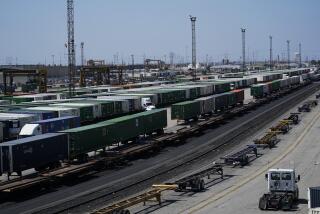Air Panel Acts : Ride-Sharing Incentive Plan to Get Hearing
- Share via
The governing board of the South Coast Air Quality Management District voted Friday to hold a public hearing Oct. 4 on a plan to make large employers offer ride-sharing incentives to their workers.
The 8-to-5 vote came three weeks after the board defeated three separate motions to call a hearing on the proposal, leading some of its supporters and air district staff to speculate that the measure was dead.
At the hearing scheduled for 9:30 a.m. at air district headquarters in El Monte, the board will take comments on the staff proposal, known as Regulation VI, and on a weaker, alternative plan offered by board Vice-Chairman Thomas Heinsheimer.
Regulation VI would require employers of more than 700 at a single site to file plans showing what incentives they will offer employees to get them to join car or van pools, or ride buses to work. The rule would apply to more than 500 employers, including government agencies, with about 1.3 million workers in the four-county air basin.
The incentives, such as subsidized bus fares or subsidized parking for ride-sharing employees, would be chosen by the employers, but the air district could reject any plan that appeared unlikely to increase ride-sharing to target levels.
The proposal is designed to increase vehicle ridership between home and work from an average of about 1.15 riders to a level of 1.3 to 1.6 riders per vehicle.
Targets for individual employers would depend on factors in their area, such as availability of bus service and inexpensive parking. For example, large employers in downtown Los Angeles would be required to seek an average vehicle ridership of 1.6, while the target would be 1.5 for San Fernando Valley employers and 1.3 for Santa Clarita Valley companies.
Employers failing to file plans or offer the promised incentives would face penalties of up to $1,000 a day, the same as for violation of all other air district rules. Failure to achieve the ridership target, however, would not be a violation as long as the effort was made.
The Heinsheimer alternative sets a uniform 1.5 average ridership target for all large employers. But the alternative does not allow the air district to reject inadequate plans or penalize violators.
The air district staff has said Regulation VI could eventually get 150,000 to 200,000 cars off the road each day, and cut daily emissions of carbon monoxide and other automotive pollutants by 80 to 200 tons.
More to Read
Sign up for Essential California
The most important California stories and recommendations in your inbox every morning.
You may occasionally receive promotional content from the Los Angeles Times.













